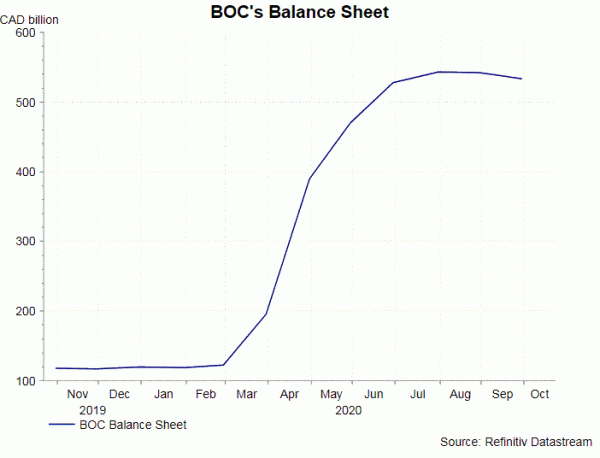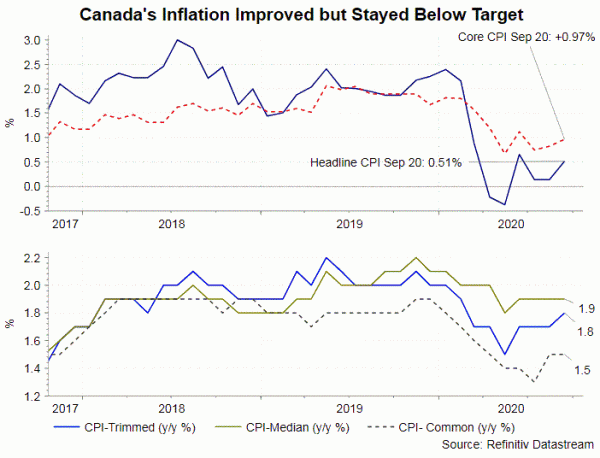BOC will likely leave the policy rate unchanged at 0.25% next week’s meeting. After surprising unwinding of some operations last week, the rest of easing measures put in place since March should remain unchanged. Inter-meeting data flow shows that economic recovery is underway in Canada. However, the pace is gradual and the outlook remains uncertain. We expect the central bank to maintain a cautious tone towards the economic outlook and the developments of the pandemic.


On the macroeconomic developments, GDP grew 3% m/m in July, weaker than +4.8% and +6.5% in May and June, respectively. From a year ago, GDP contracted -5%. August GDP data due next week probably shows further deceleration in growth at +0.9%. However, given the exceptionally pessimistic forecasts by BOC in July, we still expect to see an upgrade on 3Q20 GDP growth projection this month. On the job market, the number of payrolls jumped +378.2K in September, after a +245.8K increase in the prior month. This had also beat consensus of +156.6K increase. Participation rate improved +0.4 percentage point to 65%, signaling more optimism about the job market. The unemployment rate fell -1.2 percentage points to 9% during the month, compared with consensus of +9.7%. Headline CPI recovered to +0.5% y/y in September, from +0.1% a month ago. This came in slightly better than consensus of +0.4%. Core CPI improved to +1%, from +0.8%. Meanwhile, the average of BOC’s core inflation gauges steadied at +1.7%. While this remained the midpoint of BOC’s +2% target, stabilization of the price has reduced the need for the central bank to act aggressively in the near term.



On the flip side, retail sales disappointed, however. The headline reading gained +0.4% m/m in August, compared with consensus of +1.1% and July’s +0.6%. Market sentiment continued to improve but stayed below pre-pandemic level. BOC’s Business Outlook Survey (BOS) index for 3Q20, taken from late-August to mid-September, rose to 4.7 from -2.2 in the prior quarter. Despite the improvement, the reading remained below pre-pandemic level. Note also that the survey was taken before recent resurgence of coronavirus cases. The investment intention indicator climbed higher to +2%, from -30% previously. Yet, the reading remained weak. As such we believe BOC should retain a cautious tone in its October statement and conference.
On the monetary policy, BOC will leave the policy rate and QE unchanged. Last week, the central bank announced it would terminate some of asset buying programs implemented in March. The Bankers’ Acceptance Purchase Facility (BAPF) and Canada Mortgage Bond
Purchase Program (CMBP) will be discontinued with the final operations coming the week of October 26. Term repo operations will be conducted on a biweekly, instead of weekly, basis with conditions of eligible collateral tightened. The move was surprising but it should not imply that BOC is ending its stimulus. In fact, the operations due to cease have lacked demand. Concerning the outlook, BOC Governor Tiff Macklem reiterated earlier this month that negative interest rate has not been ruled out although this option has not been actively discussed. Yet, the central bank changed its definition of the effective lower bound from -0.5% in December 2015 to 0.25% in March/April. We believe policymakers are more inclined to leaving the policy rate unchanged at the current level for an extended period of time, than lowering it further. He also mentioned about adoption of unconventional monetary policy measures. We do not believe much news to be announced at the upcoming meeting.


 Signal2forex.com - Best Forex robots and signals
Signal2forex.com - Best Forex robots and signals




